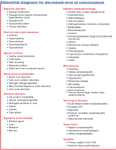Splish, splash - What went wrong in the bath?
A 2-year-old boy is experiencing episodes of pallor, perioral cyanosis, and becoming limp after bath time.

The initial workup
An electrocardiogram (ECG) was performed that revealed a normal sinus rhythm and normal intervals, making a prolonged QT interval leading to an arrhythmia unlikely as the cause of this event. An electroencephalogram (EEG) and MRI were also performed. Both were completely normal. Although a febrile seizure was discussed, the etiology remained unclear, and the patient was eventually discharged home. The parents were taught CPR and advised to return if the event recurred.
The patient's mother tells you that nearly a year later, trouble began again. The child was at daycare and was noted to be walking with some difficulty. Similar to a year prior, he again became limp, pale, and cyanotic. He again had an altered level of consciousness during the event. This event lasted for about five minutes. There was no fever or preceding illness. He had not received any immunizations. Later that same day, the mother reports that as she was taking him out of the bath, yet again he became limp, pale, and cyanotic. The event lasted a few minutes, and the patient was lethargic for a short time afterwards. The patient was brought to the hospital and presumptively diagnosed with a seizure disorder. He was started on carbamazepine (Tegretol) and sent home with a follow-up appointment with a neurologist. He remained on carbamazepine for only two weeks, as his physicians remained unconvinced that these were seizures. A few weeks later, he was again admitted to the hospital for a similar event, again following a bath. His mother reports that he became limp, pale, and had perioral cyanosis several minutes after being removed from the bath. An EEG was again negative and the episodes did not recur in the hospital. No diagnostic tests were performed, and the patient was sent home. The physicians began to question whether the mother was fabricating some of these symptoms.
A few months later, while in pre-school, he was noted to have a cyanotic event while napping. He started retching in his sleep and the daycare provider found him to be limp, cyanotic, unresponsive, and apneic. Rescue breaths were given and chest compressions started while 911 was called. There was no evidence of tonic-clonic movements, eye deviation, facial movements, or other seizure activity with this event. There was no preceding illness or fever. The patient was again admitted for further evaluation and monitoring. During his admission the EEG, ECG, and MRI with angiography were all found to be normal. A transthoracic echocardiogram was normal as well. Loop/event monitoring revealed no arrhythmia during an event witnessed by the nurses on the floor. The patient often gagged before and after these events-could severe gastroesophageal reflux be the cause? It seemed unlikely given the severity, but a barium swallow and milk scan were done. These were also normal. Although multiple consultants conducted many diagnostic tests, the etiology of these events was still unclear.